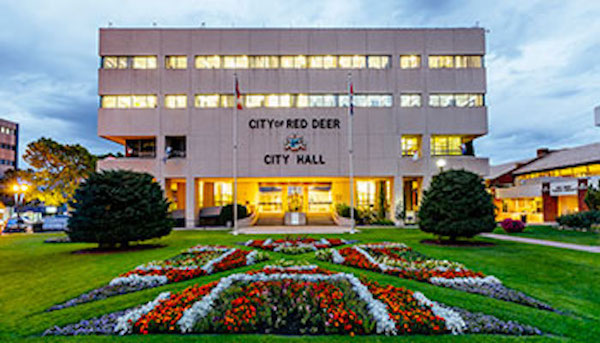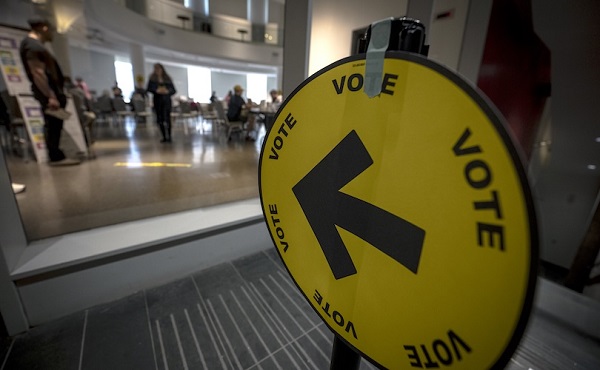City of Red Deer
Swim tops now optional at City of Red Deer Aquatics Facilities

Aquatics guidelines updated to align with Alberta Human Rights Act
Appropriate swim attire, which is now clearly defined in the guidelines, requires all swimmers to wear swim bottoms; the use of a swim top is a patron’s choice. The update is about more than just swim tops though; it’s about allowing options for different people, cultures and religions while still being safe. It is about allowing things like burkinis, full coverage of head/legs, allowing shorts and t-shirts, to name a few. The full definition of appropriate swim attire includes a broad variety of options to ensure all visitors can comfortably and safely access pool spaces.
“We do not discriminate based on gender, gender identity or gender expression. We are now in alignment with Alberta Human Rights Act,” said Ken McMullen, Acting City Manager. “We must always be looking at our own practices, operations, and services, finding ways to evolve and recognize the diversity in our community.”
The purpose of the Alberta Human Rights Act is to ensure all Albertans are offered an equal opportunity to earn a living, find a place to live, and enjoy services customarily available to the public without discrimination. The Act has not changed recently, however, several other cities in Alberta have recently adjusted their guidelines, which triggered a review of The City’s aquatics guidelines.
“We are constantly connecting with community, reviewing recreation industry leading practices and working with other communities to understand how we can adjust our operations to fulfil our commitment of providing accessible recreation opportunities for everyone,” said Barb McKee, Recreation Superintendent. “This update is a perfect example of how important that collaboration is; it pushes us to continually develop a better understanding of the needs of our community, and what shifts we need to make to align them with regulating bodies.”
Before heading to one of our aquatic facilities, take a read through our detailed Question and Answer sheet FAQ – Updated Aquatics Facilities Use Guidelines (pdf), or review the newly updated Aquatics Facilities User Guidelines Aquatics Facilities Use Guidelines (pdf).
The City of Red Deer adjusted its Aquatics Facilities Use Guidelines to align with Alberta Human Rights Act, by clearly defining appropriate swim attire.
- What adjustments have been made to the swim attire requirements?
In the updated guidelines, swim attire is clearly defined and focuses on being inclusive while ensuring the health and safety of all visitors. In the definition, it outlines that all aquatics visitors must wear swim bottoms; the use of a swim top is a patron’s choice. This change isn’t just about not being required to wear a swim top. It is about our definition of appropriate swim attire recognizing options for different cultures, religions etc. It is about clearly outlining that we allow attire like Burkinis, full coverage of head/legs, allowing shorts and t-shirts, to name a few.
Previously in the Aquatic Facilities Use Guidelines, appropriate swim attire was not defined. Prior to the adjustments to the guidelines, The City’s practice for appropriate swim attire required bottoms and tops for females, and bottoms for males, in addition to other best practices for attire that limits health and safety risks for our staff and visitors.
- Are the guidelines in alignment with the Alberta Human Rights Act?
Yes, the revised guidelines are in alignment with the Alberta Human Rights Act; we do not discriminate based on gender, gender identity or gender expression. - Why are the guidelines changing?
The updates are a result of a recent review, to align with the Alberta Human Rights Act. The new appropriate swim attire definition was written in partnership with the Lifesaving Society, in compliance with Alberta Health Services, and aligns with Alberta Human Rights Act. While the Act is not new, The City has gained a better understanding of the Act and adjusted to align with the Act.Additionally, The City is always striving to do better. The safety and wellbeing of all customers and citizens in our community is a priority. As an organization, we strive to ensure welcoming and inclusive spaces and places for all, prioritizing inclusive practices and equitable access across our organization and our community.
- Why does The City have to align guidelines with the Alberta Human Rights Act?
A municipality cannot opt out of alignment with the Alberta Human Rights Act.
If a municipality does not adhere to the Act, a complaint can be brought to the Alberta Human Rights Commission within one year of the alleged incident or discrimination. The Commission works with the parties to resolve the complaint.
- Where does the Aquatics Facilities Use Guidelines apply?
The revised Aquatic Facilities Use Guidelines apply specifically to City of Red Deer operated aquatic facilities and the adjoining spaces such as change rooms and saunas. City operated aquatic facilities include:- G.H. Dawe Community Centre pools
- Collicutt Centre pools
- Michener Aquatics Centre pools
- Recreation Centre indoor and outdoor pools
- Why do the Aquatics Facilities Use Guidelines only apply in aquatic spaces?
Safety and hazard assessments are conducted for all areas within any City facility. Use guidelines are established based on these assessments to ensure the safety of all patrons accessing specific areas within a City facility. Use guidelines, and the required attire and/or equipment, for each area may vary from space to space, depending on its intended uses. Patrons accessing other City of Red Deer spaces within those facilities, such as open public spaces (hallways), field house, gymnasium or ice surface are required to wear a top and other attire and/or equipment such as clean running shoes, skates or helmet.
Ensuring the safety and wellbeing of all citizens in our public spaces and places, balanced with ensuring feelings of inclusivity, are a priority for The City of Red Deer.
- Are people still able to go swimming at City facilities fully clothed?
Another area of focus in our Aquatic Facilities Use Guidelines is safety. Swimwear must be suitable for general participation and must not impair a person’s ability to swim. Swimwear can be made of different fabric if it does not put a person’s health at risk or interfere with the quality of the pool water. You can find the full definition of appropriate swim attire in our Aquatics Facilities Use Guidelines athttps://www.reddeer.ca/media/reddeerca/recreation-and-culture/facility-and-parks-rentals/Aquatics- Facilities-Use-Guidelines.pdf - How will citizens be notified about the change in Aquatics Facilities Use Guidelines?
Information about appropriate swim attire is shared with aquatics visitors in many ways, including but not limited to on-site communications and program and service information. We will continue to share information about appropriate swim attire through our website, formal guidelines and sport partner communications to ensure facility visitors understand what guidelines are in place. - Will there be accommodations made for people who feel uncomfortable with the change in swim attire requirements?
No, we will not be setting up specific times where swim tops will be required for users in our aquatics facilities. We recognize some people may be uncomfortable with this adjustment, but we will continue to allow any person to use our aquatics facilities without a swim top. Our guidelines ensure fairness to everyone and are in alignment with the Alberta Human Rights Act. - Where can I get more information about swim attire in City aquatics facilities?
The adjusted Aquatics Facilities Use Guidelines provide detailed information about appropriate swim attire, including material, swimwear style and additional requirements when entering our pools. You can find full swim attire definition on the last page of this document, or the full guidelines here: https://www.reddeer.ca/media/reddeerca/recreation-and-culture/facility-and-parks-rentals/Aquatics- Facilities-Use-Guidelines.pdf - What if I don’t agree with the change?
The City understands there are diverse opinions in the community about topics like this, related to swim attire or other diversity and inclusion initiatives and efforts. This change to swim attire guidelines in City operated facilities stems directly from a need to align with the Alberta Human Rights Act, which falls under provincial authority.
If you do not agree with this change, you can visithttps://albertahumanrights.ab.ca/complaints/Pages/complaint_info.aspx to file an official complaint.
12. What is the definition of appropriate swim attire in the guidelines? Appropriate swim attire definition:
The City of Red Deer is committed to providing safe and welcoming recreation spaces. We want all people to feel comfortable in and around our aquatic amenities.
In partnership with the Lifesaving Society, and in compliance with Alberta Health Services, The City of Red Deer has developed the following definition for appropriate swim attire. This definition also ensures that City of Red Deer pool operations are aligned with the Alberta Human Rights Act, which does not allow for discrimination based on gender, gender identity or gender expression.
City staff have the responsibility to determine if swimwear poses a safety risk and will manage facility use accordingly.
- When visiting a public pool, swimwear must be suitable for general participation in aquatics and must not impair swimming skills. Swimwear may be made of different types of fabric as long as it does not put a user’s safety at risk or interfere with pool water quality.
- When patrons choose not to expose a part of their body, a modified version of traditional swimwear is permissible as an alternative. Acceptable alternatives for swimwear include:
i. footless tights, gymnastic leggings, ii. tight-fitting undershirt,
iii. tight-fitting hood that covers the head and neck with wide openings for the face, iv. tight-fitting sweater or pants, or a wetsuit,
v. long-sleeved pants and shirts,
vi. tee-shirts and shorts with undergarments or a swimsuit worn underneath,vii. burkinis and rash guards, where there is a wide opening for the face and fabric is tight-fitting enough to not interfere with swimming skills. Hands and feet must be able to move freely.
- For safety reasons, patrons wearing traditional garments (such as saris) are asked to remain in the shallow end of the pool. We ask that they not use the dive tank.
- All patrons are required to wear swimwear bottoms. The use of swimwear tops is a patron’s choice.
- Clothing that absorbs water and becomes heavy is not permissible in pools.
- All swimwear must be clean and brought to the facility for the purpose of swimming.
- Prior to entering the pool, all patrons are required to take a cleansing shower in their swimwear.
- Children under 3 years of age and anyone who is incontinent must wear a reusable/disposable swim diaper as well as a fitted plastic pant.
City of Red Deer
Cindy Jefferies is Mayor. Tristin Brisbois, Cassandra Curtis, Jaelene Tweedle, and Adam Goodwin new Councillors – 2025 Red Deer General Election Results

Showing official results for: Mayor of The City of Red Deer
| # | Candidate Name | Votes | Percentage |
|---|---|---|---|
| 1 | JEFFERIES, Cindy | 6237 | 41% |
| 2 | SCOTT, Gareth | 3483 | 23% |
| 3 | DOERKSEN, Victor | 3143 | 20% |
| 4 | LEE, Lawrence | 2215 | 14% |
| 5 | GALLAGHER, John | 298 | 2% |
| Rejected Ballots | 0 | 0% |
Showing official results for: Councillor of The City of Red Deer
| # | Candidate Name | Votes | Percentage |
|---|---|---|---|
| 1 | BRISBOIS, Tristin | 6703 | 7% |
| 2 | CURTIS, Cassandra | 6422 | 7% |
| 3 | KRAHN, Chad | 6249 | 7% |
| 4 | BARNSTABLE, Kraymer | 6235 | 7% |
| 5 | WYNTJES, Dianne | 6069 | 7% |
| 6 | TWEEDLE, Jaelene | 5635 | 6% |
| 7 | GOODWIN, Adam | 5290 | 6% |
| 8 | BURUMA, Bruce | 5241 | 6% |
| 9 | GOULET-JONES, Calvin | 5050 | 5% |
| 10 | HUIZING, Hans | 4810 | 5% |
| 11 | BOUCHARD, Brandon | 4528 | 5% |
| 12 | MACDONALD, Ashley Jason | 3832 | 4% |
| 13 | BUCHANAN, Buck | 3660 | 4% |
| 14 | MOHAMOUD, Zainab | 3478 | 4% |
| 15 | SYPKES, Thomas | 3459 | 4% |
| 16 | BECK, Gabriel | 3370 | 4% |
| 17 | PARKS, Gail | 2809 | 3% |
| 18 | YZERMAN, Calvin | 2265 | 2% |
| 19 | WILE, Haley | 1986 | 2% |
| 20 | COMÉTE, Christian | 1843 | 2% |
| 21 | KLERKS, Kevin M. | 1699 | 2% |
| 22 | ROBINSON, Don | 1296 | 1% |
| 23 | MARTIN, Greg | 656 | 1% |
| 24 | KLYWAK, Anthony | 444 | 0% |
| Rejected Ballots | 0 | 0% |
Showing official results for: Trustee of the Red Deer Public School Division
| # | Candidate Name | Votes | Percentage |
|---|---|---|---|
| 1 | SOMMERS, Angela | 3320 | 9% |
| 2 | BUCHANAN, Nicole | 3180 | 9% |
| 3 | MACAULAY, Dianne | 3119 | 8% |
| 4 | WATTERS, Jim | 3038 | 8% |
| 5 | BAIRD SMITH, Emilee | 2753 | 7% |
| 6 | DAVIES, Nathan | 2749 | 7% |
| 7 | DALSTRA, Jason | 2722 | 7% |
| 8 | CHRISTENSEN, Sheri | 2701 | 7% |
| 9 | PARKER, Jenessa | 2581 | 7% |
| 10 | PEACOCKE, Cathy | 2573 | 7% |
| 11 | WILLIAMS, Danielle | 2342 | 6% |
| 12 | ODISHAW, Shelley Lynn | 2187 | 6% |
| 13 | SYMONS, Jessica | 1881 | 5 |
Trustee of the Red Deer Catholic Separate School Division, Red Deer Area Ward
| # | Candidate Name | Votes | Percentage |
|---|---|---|---|
| 1 | ANDREW, Chris | 2020 | 14% |
| 2 | MACDONALD, Brenda | 1354 | 10% |
| 3 | REED, Martin (Marty) | 1082 | 8% |
| 4 | LEYSON, Cynthia | 1050 | 8% |
| 5 | HUBER, Emily | 1037 | 7% |
| 6 | HOLLMAN, Murray | 1036 | 7% |
| 7 | DONOVAN, Matthew | 1021 | 7% |
| 8 | GROENEN, John | 974 | 7% |
| 9 | STEEVES, Rod | 921 | 7% |
| 10 | PASULA, Kim | 911 | 7% |
| 11 | BECK, Gabriel | 825 | 6% |
| 12 | HUNTER, Ashley | 811 | 6% |
City of Red Deer
Plan Ahead: Voting May Take a Little Longer This Election Day

News release from the City of Red Deer
Voters are encouraged to plan their vote and allow a little extra time at the polls this Election Day, Monday, October 20.
Because this year’s election uses Alberta’s new Permanent Elector Registry, voting may take slightly longer than in previous years. Municipalities are required to provide updated voter information back to the province after the election. As a result, many voters will be asked to complete an Elector Register Form (Form 13) at the voting station — even if they are already registered to vote. This ensures that voter information is accurate and up to date. Once the registry information has been updated, all forms are securely shredded.
Additionally, the Permanent Elector Registry is not shared with local school boards, so anyone voting for a School Board Trustee must also complete an Elector Register Form (Form 13).
We appreciate voters’ patience as our election teams work to ensure every eligible voter can cast their ballot accurately and securely. Once the voting process begins, most voters complete their vote in about 10 minutes.
To help avoid lineups, voters can visit Red Deer Elections website to check real-time wait times at each voting station and choose the location with the shortest line.
Anyone who arrives at a polling station and joins a line before 8 p.m. will be able to vote.
Thank you for your understanding and for taking the time to make your voice heard in Red Deer’s 2025 Municipal and School Board Election.
-

 Agriculture1 day ago
Agriculture1 day agoEnd Supply Management—For the Sake of Canadian Consumers
-

 Digital ID1 day ago
Digital ID1 day agoCanadian government launches trial version of digital ID for certain licenses, permits
-

 Alberta1 day ago
Alberta1 day agoAlberta Next Panel calls to reform how Canada works
-

 International20 hours ago
International20 hours agoGeorgia county admits illegally certifying 315k ballots in 2020 presidential election
-

 Business23 hours ago
Business23 hours agoThe “Disruptor-in-Chief” places Canada in the crosshairs
-

 Artificial Intelligence1 day ago
Artificial Intelligence1 day agoUK Police Pilot AI System to Track “Suspicious” Driver Journeys
-

 Energy19 hours ago
Energy19 hours ago‘The electric story is over’
-

 International1 day ago
International1 day agoWorld-leading biochemist debunks evolutionary theory






